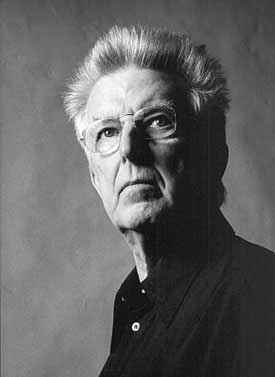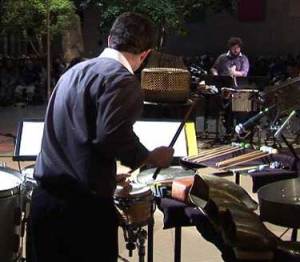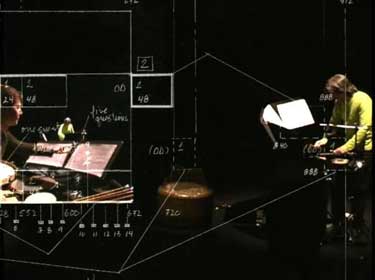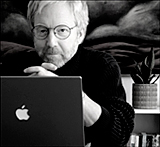In the Sanctuary: Roger Reynolds
By Stephen Brookes • The Washington Post • November 18, 2007
____________________________________________________________________

Roger Reynolds Photo: Malcolm Crowthers Tonight at 6:30, the guards at the National Gallery of Art will close and lock the doors of the East Building, sealing it off from the outside world. And in the vaulting atrium -- where Alexander Calder's 76-foot-long mobile famously turns -- a strange and almost otherworldly ritual will start to unfold. Grouped around a bizarre-looking piece of metal called the Oracle, a quartet of percussionists will begin to play, passing fragments of sound back and forth, posing "questions" to the Oracle and responding to its answers. And slowly, gradually, as the percussive clatter begins to cohere, intricate melodies and complex harmonies will emerge -- as if song, or maybe even language itself, were first being born.
It's like a scene out of a primitive past, but "Sanctuary" -- a new work by the Pulitzer Prize-winning composer Roger Reynolds -- is about as cutting edge as it gets. These percussionists won't just be banging on drums; every sound they make will be fed into a computer, transformed in real time into strange and wildly complex new forms, then channeled throughout the vast expanse of the atrium through a carefully placed network of speakers.
It's music, in a sense, for meta-musicians -- players who can turn the tiniest movements of their fingers into waves of sound so gigantic they can fill a cathedral.
"This is an extension of human capacity -- of doing things which could otherwise not occur," Reynolds says. "The gestures become larger than life, allowing the acts of the percussionist to take on larger significance."
For Reynolds, 73, "Sanctuary" is the latest -- and perhaps most intriguing -- in a series of technologically advanced works he's been mounting for decades, incorporating everything from theater to computers to experimental psychology, to extend the boundaries of human listening. The founding director of the Center for Research in Computing and the Arts at the University of California at San Diego, he's that rarest of musical birds -- a composer as much at home at the bleeding edge of technology as he is in the more traditional world of music.

Performing "Sanctuary" at the National GalleryIt's also unusual to find a composer as committed to electronic music as Reynolds is; most seem to view it as a quaint artifact of the 1960s and continue to write for traditional instruments in traditional settings. It's an attitude Reynolds -- who, significantly, was originally trained as an engineer -- finds hard to fathom.
"There's a great deal of resistance to using computers in music -- they're seen as inhuman," he says. "But the computer has the capacity to take what was in the province of the imagination, and turn it into experience. And this is new in human history."
Technology has also allowed Reynolds to bring music out of the concert hall and into places like the Guggenheim Museum and Kenzo Tange's Olympic Stadium in Tokyo, settings that have dramatically altered the relationship between performer and audience. In tonight's concert, listeners will be placed on all three levels of the atrium, some of them changing position between movements.
"There's nothing else like this piece, especially in terms of technology. It's among the newest things in the world," says percussionist Steve Schick, who will be leading the ensemble red fish blue fish in the hour-long, three-movement work. Aided by the CRCA's Ian Saxton and Jacob Sudol on a computer, the group will be using cutting-edge software (designed by the University of California's Miller Puckette), as well as lighting and staging designed to create something beyond the usual concert experience.
For all its advanced and unusual technology, the work had the humblest of beginnings -- as a crayon sketch in (perhaps appropriately) a Greek restaurant.
"It was one of those places that has paper tablecloths and crayons to keep the kids busy," says Schick. "I asked him about doing a new piece, and we started sketching things out. And as this diagram materialized, it seemed like it was almost a flow chart for the history of contemporary percussion music. In one sense, it's a piece about percussion itself."
Schick himself will be wired directly into a computer via motion sensors -- small piezoelectric devices attached to his fingers -- that will turn even the most delicate gestures into new sounds. Amplified throughout the cathedral-like space of the atrium via a dozen speakers, the effect radically alters perspective and scale in surprising ways.
 But the most intriguing aspect of the work may be the Oracle itself. It's a "waterphone": a unique, handmade instrument with what Reynolds calls a "beguiling" voice and an unusual background.
But the most intriguing aspect of the work may be the Oracle itself. It's a "waterphone": a unique, handmade instrument with what Reynolds calls a "beguiling" voice and an unusual background.
"We were looking for an instrument that had a sophisticated palette of sounds," says Schick. "And we came across this old piece of junk, made by somebody far before our time. It's the canister of a washing machine, to which about fifty metal rods of different lengths have been welded. You can play the body of the canister -- which is a sort of noisy, reverberant instrument -- and then the little metal rods create individual tones in a kind of scale."
Whatever predictive powers it may have, the Oracle is at the heart of the meaning of the piece, which explores intersecting ideas of communication, sanctuary and, ultimately, authority. The work is structured, says Reynolds, to be a "safe place" where questions can freely be asked, allowing communication between players to develop from inchoate musings into meaningful, complex thought. And driving that evolution is the appeal to some sort of higher authority, whose identity remains deliberately vague.
"The issues underlying the 'Sanctuary' idea for me are: How do we ask the right questions, and to what authority do we address them?" says the composer. "The search for an acceptable and useful authority is an important contemporary issue."
Sanctuary, by Roger Reynolds, will have its world premiere, performed by the ensemble red fish blue fish, in the Atrium of the East Building of the National Gallery of Art tonight at 6:30, preceded by a talk by the composer.
For more on Sanctuary, click here. To see videos of parts of the work, click here. For Roger Reynolds' website, click here. For more on Steven Schick, click here. To read Andrew Lindemann Malone's interview with Steve Antosca of the Contemporary Music Forum, click here.


Reader Comments (4)
And now we head into weeks and weeks and weeks of nonstop ... Messiah .... *grits teeth*
Excellent review, by the way! Not sure I agree that Reynold's pre-concert Powerpoint talk was illuminating -- I don't speak academese as well as I used to -- but the work itself definitely was "revelatory." Let's petition for another performance!
Andrew's review here:
http://www.washingtonpost.com/wp-dyn/content/article/2007/11/19/AR2007111901561.html